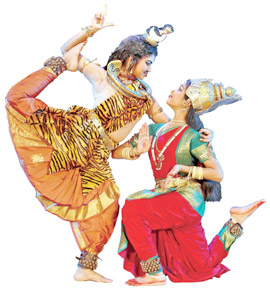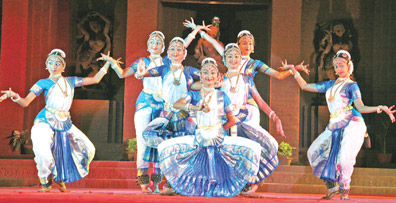Changing trends in classical Bharatha Natyam
Subashini PATHMANATHAN
Any classical dance form has vast and systematic principles developed
over centuries. Practical side of the art form is firmly coordinated
with theory. Bharatha Natyam has strong links with old Sanskrit scripts
and Sastras. Earlier it was traditionally performed in temples, courts
and social functions.
 |
|
Facial
expressions are important in Bharatha Natyam |
After a period of oblivion this art has regained its earlier status
and social recognition. Natya sastra of Bharatha Muni provides the basic
guidelines to all Indian classical dance forms.
In Bharatha Natyam there are four varieties of abinayas altogether:
Angika Abinaya, Akariya Abinaya, Vaachika Abinaya and Sathvika Abinaya.
All these four varieties of Abinayas are not used in the present dance
field with the same enthusiasm, yet a lot of changes have taken place in
handling these abinayas. Ankiga Abinaya means articulating the meaning
of the song through angas (organs) and systematically executing the pure
nirtha (adavus) through angas. But today teachers do not adhere to the
basic principles or format of adavus.
A lot of changes have taken place recently, even in the basic format
of the adavus in the Isthana positions. Most of the Bharatha Natyam
artistes, even the exponents introduce numerous innovations in the
classical dance forms. Present trend in classical Bharatha Natyam by
adopting old cinema trend group dances by forming different formats,
circles, straight lines, crossing lines, and corner line formations.
Front line moving to the back line, meanwhile the back line moving to
the front is a quite common scene nowadays in classical dances.
Bharatha Natyam is purely a solo dance performance. But with the
passage of time due to the emergence of institutions, Bharatha Natyam
has started teaching at the group level to accommodate more students.
These new self-adopted techniques are less relevant with the classical
Bharatha Natyam dance form. For instance basic adavus are changed many
times according to the needs and according to the ideologies of the
professional dancers and dance teachers.
Earlier the dancers used the stage according to their needs of the
adavus (steps). But today the Bharatha Natyam, dance teachers and
dancers cover up the whole stage according to their wishes, with twists,
turns, runs and jumps.
Facial expressions are more important for Bharatha Natyam. Facial
expressions are more important to reveal the Navarasas. The absence of
facial expressions is the common feature today in the classical Bharatha
Natyam. Mechanical way of performances is the general trend in the
present Bharatha Natyam field. They adopt the adavus according to their
own ideologies. Mainly they try to introduce superficial ways of anga
movements as in the silver screen where the movements are adopted to
rhythmic requirements. This attitude of some artistes would definitely
affect the future dance generation.
Earlier this art form was practised mainly in temple rituals. It
enables one to grasp the significance of the classical dance form. But
today this dance form is mainly practised in public halls and public
stages for entertainment purpose.
Due to scientific developments in technical aspects, various outside
aspects have been introduced to enhance performances. Even more
attention is paid for the stage decor that even affects the presentation
of dance performances many of times. Akariya Abinaya in Bharatha Natyam
means dresses, costumes, use of ornaments and make up. Earlier simply
draped sarees were used for dancing but later sculpture-based design and
stitched costumes were adopted for dance. These costumes were further
modified in Bharatha Natyam scenes in the cinema by using tight pyjamas.
 |
|
A group of
dancers |
Colouring the palm and feet with red is a decorative aspect entered
the dance world. But today some dance teachers and students are using
the same classical Bharatha Natyam costumes and make-up for different d
Vaachika Abinaya means expressing the meaning of the song through the
mouth. Earlier in the dance the dancer herself was supposed to sing but
with the passage of time the vocal support is given by outside vocalist.
This prevents the artiste from singing by herself and limits the scope
to use this abinayas. Moving the lips provides more chance for the
artiste to show her involvement with the art. But many of the present
generation teachers prevent the students from moving the lips even
slightly. This destroys the spirit of the art and Vaachika Abinaya of
the art is totally ignored in the art. Vaachika Abinaya to some extent
provides the meaning of the song.
Sathvika Abinaya is another division in the classical dance form.
Sath means involving the art emotionally. The artiste has to involve
herself with the art fully in this category. The artiste is supposed to
forget herself fully and involve herself totally with the art. Then one
only can express the feeling of the song thoroughly with full emotional
involvement. This is called manothrama interpretation of the song though
abinayas, bavas, and rasas. But today most of the dancers do not perform
themselves with full interest; hence their dance performances are
mechanical.
However in a traditional art form the standards should be reserved.
Maintaining the aesthetic values of the art is an important factor for
the survival of the art form. To reveal the Navarasa emotional the
absence of facial expressions are the common feature today in the
classical Bharatha Natyam. Mechanical way of performances is the general
trend in the present Bharatha Natyam field.
|



